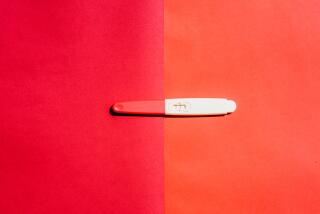More Than One Can Conceive
- Share via
CLEVELAND — The elephant dung was no trouble at all. When the circus came to town, Percy Skuy simply showed up with a bucket and politely asked the keeper if he could collect a few droppings.
The mule’s earwax? Now, that was a challenge. Skuy asked a friend in Mexico for advice. A few weeks later, the friend sent back photos of two ranch hands struggling to hold a mule while a third extracted a clot of wax from a hairy ear.
Skuy set the greasy blob on black velvet, near the vial of elephant dung.
Another exhibit successfully mounted in the History of Contraception Museum.
In a 40-year quest to document the science -- and superstition -- of family planning through the ages, Skuy has sought out weasel testicles and hairy spiders, carrot seeds, candy wrappers and a bone from an all-black cat. He has collected hundreds of IUDs and cervical caps. He has preserved the first, experimental female condoms and the short-lived “cerviscope” of the 1960s, an awkward device designed to help women monitor their fertility.
It is a lonely obsession. And a frustrating one.
As Skuy, a retired pharmaceutical executive, points out with some sorrow, “there’s really no motivation to save an old contraceptive.”
Still, here and there, gynecologists and patients with a sense of history have held on to favorite devices. Skuy, 72, has traveled the globe to acquire them. His collection, he says, is more than a curiosity: It’s about science and sociology, about the limits of modern medicine and the ageless drama of human desire.
The artifacts “tell of a human motivation across the centuries, in different countries and different cultures, to limit family size,” he said. “There are any number of museums that display fertility symbols. The story of how people tried to curb their fertility is every bit as important.”
Plus, he says genially, “people find it interesting.”
This month, Skuy donated his one-of-a-kind collection to the Dittrick Medical History Center here at Case Western Reserve University. Hundreds of contraceptives -- some ingenious, some barbaric -- are on display in glass cases in the medical library, accessible to scholars, students and anyone curious about early IUD design or faux crocodile-skin condoms.
“It’s such an honor,” said Jim Edmonson, the center’s curator. “These surviving objects tell us a story you can’t find in the literature.”
The story starts in 1550 BC, with a prescription written on papyrus: “To cause that a woman should cease to conceive,” moisten a bit of wool lint with honey, mix in ground dates and the tips of acacia flowers and use the sticky wad as a vaginal suppository. Like many ancient methods, this one might actually have worked: Acacia breaks down to lactic acid, a spermicide used even today.
The animal dung women used as suppositories in ancient India may have been effective too: Some manure is acidic enough to kill sperm. But the earwax amulets popular in the Middle Ages? Not a chance. Still, Skuy cautions against ridiculing such folklore.
“Men today spend an inordinate amount of money on rhinoceros horns and elk antlers as aphrodisiacs,” he points out. “If people can do that in the 21st century, it’s easy to understand these old superstitions.”
And not all was superstition. Hundreds of years before scientists understood reproduction -- sperm was not observed under a microscope until 1677 -- men and women invented birth control strikingly similar to modern contraceptives.
The museum documents the use of cervical caps made of lemon halves, natural sea sponges dipped in olive oil, and condoms fashioned from sheep intestine. It explores approaches to oral contraception long before the pill: Women in China 4,000 years ago drank mercury, which probably did sterilize them if it didn’t kill them. In 17th century India, women munched carrot seeds as a post-coital contraceptive. In parts of Canada, even today, some women steep dried beaver testicles in alcohol, then drink the potion.
Skuy has been pushing for someone to test the efficacy of that last concoction with a scientific experiment. So far, no one’s taken him up on it.
But he is not one to give up.
“Anything he undertakes, he undertakes with passion and commitment,” said his wife, Elsa.
She long ago adapted to visiting gynecologists’ offices on every exotic trip she and her husband took. Quite possibly, she’s the only tourist ever to give up a day of sightseeing in Nepal to hang out in a squalid women’s hospital, waiting to ask the director whether he had any birth control devices to spare. She didn’t mind.
“I find it interesting to see how other people live,” Elsa said.
Growing up in a small South African village, Skuy showed a bent for collecting items that others might deem worthless when he amassed a great quantity of sample-sized toothpastes.
But he didn’t stumble on his passion for birth-control products until the 1960s, when he got a job as a sales representative for Ortho Pharmaceutical in Toronto.
Ortho had just introduced one of the first birth-control pills. It also made diaphragms, jellies, condoms and other contraceptives; Skuy was assigned to sell them to physicians.
The trouble was, it was a criminal offense in Canada until 1969 to promote or advertise contraceptives. And most doctors knew nothing about birth control. It wasn’t considered a medical issue.
So Skuy found he had to do a lot of educating -- in secret. He would hide a diaphragm in his suit pocket and wander the halls of a hospital. When he came across a young doctor, he would pull him into an empty room and explain how the product worked. He also passed out placards for physicians to put on their desks -- “Family Planning Information Available” -- to spare them from having to broach the subject with their patients.
In 1965, Skuy was asked to speak to a pharmacists group about the latest methods of contraception. He opened his talk with a few remarks on the history of birth control. That introduction proved so popular, the pharmacists invited him to expand on it for a bigger crowd a few months later.
Skuy searched Ortho’s archives for old birth-control prototypes to enliven his speech. He soon realized that most of what he sought had long since been tossed in the trash.
Solid-gold cervical plugs from the 1930s. Early IUDs shaped like butterflies, bows or coiled snakes. Condoms bought and sold on the black market.
“These were truly one-of-a-kind things, and people were not saving them,” Skuy said.
So he set out to do it himself.
His bosses at Ortho encouraged him. Or, at least, Skuy said upon further reflection, they never told him to stop. In 1973, he became president of the company. And everywhere he went, he put out word that he wanted contraceptives.
“I’ve heard every condom joke there is,” he said ruefully. But many also took his hunt seriously.
Dr. Jack Lippes, who invented the IUD design known as the “Lippes Loop,” donated dozens of experimental devices he had crafted in different shapes and sizes. Gynecologists the world over sent in odd devices they had removed from patients -- including one IUD made from knotted fishing line. (It evidently worked, as the woman had worn it for a decade without conceiving.)
Even rival companies contributed their artifacts, once Skuy assured them that the collection was a personal passion, not a business venture. It contains no brand-name products.
Skuy scanned medical journals and newspapers for reports about curious attempts at contraception, such as the Australian boys who used candy wrappers as condoms or the British woman who used the top of a teapot as a diaphragm.
When traveling, he made a point of asking local guides about their customs.
“I would move from ‘Show us the local temple,’ to ‘Let’s go look for a family planning clinic,’ ” he said. “It was a priority.”
Once, in India, a guide showed him a neem tree, renowned for its medicinal properties. Skuy remembered reading that Indian women used to steep branches from the tree in a special “fumigation” kettle, then stand over the steam after intercourse, hoping that would prevent pregnancy. He snipped off a few branches for his museum. His wife, a professional potter, made a ceramic replica of a fumigation kettle for the display.
As his collection grew, Skuy took it to medical conventions across Europe and Asia. Participants often tipped him off to colleagues who collected interesting devices -- which is how Skuy ended up in an Israeli gynecologist’s office, bartering several duplicates from his collection for three crude homemade metal IUDs she had removed from Russian patients.
“They were trading, like you might trade hockey cards!” Elsa recalled.
Other finds were pure serendipity.
One day in the 1980s, a woman came to Skuy’s office to offer him a link from her charm bracelet.
It was a small gold wishbone. She had come across it in her husband’s pharmacy, and finding the shape fanciful, had hooked it on her bracelet. There it remained for two decades -- until she saw a newspaper photo of Skuy’s collection and realized that her beloved charm was an old-time cervical plug.
Such devices suggest that “as science and medicine raced ahead in the 20th century, family planning was always hobbling along behind,” with couples forced to use crude and often ineffective methods, said Malcolm Potts, a professor of family planning at UC Berkeley.
“The museum isn’t a place to giggle at,” he said. “It gives a very important message to contemporary society that family planning has been universally wanted by women.”
Though family planning is often divisive, the museum did not draw a single protest during the many years Skuy displayed the objects in the lobby of Ortho’s Toronto headquarters. After retiring in 1995, he began to consider how to make it more accessible. He chose the Dittrick center in part because it has a large collection of old medical devices, including dozens of antique obstetrical forceps.
Edmonson, the curator, plans to add context and social history to the exhibit over the next few years.
Even with the current bare-bones display, the collection has attracted interest. Several professors plan to build courses around the exhibit. And students wandering through the hushed reading room invariably stop to check it out.
“With all the debate over birth control these days, I thought it was a more modern issue,” said Alex Vikmanis, a junior. “But it’s been such a common theme throughout history, it really shouldn’t be such a big deal.”
Graduate student Elizabeth Salem was so taken with the exhibit, she said she hoped to write her dissertation about it. She’s studying women’s history -- but rarely, she said, does the subject come alive as it does in a museum full of brutally painful, astoundingly creative or woefully ineffective contraception.
“Sometimes it’s hard to picture what life was like when you’re plowing through medical case histories,” she said. “But when you see the objects, it’s like, ‘Oh, my goodness.’ ”


